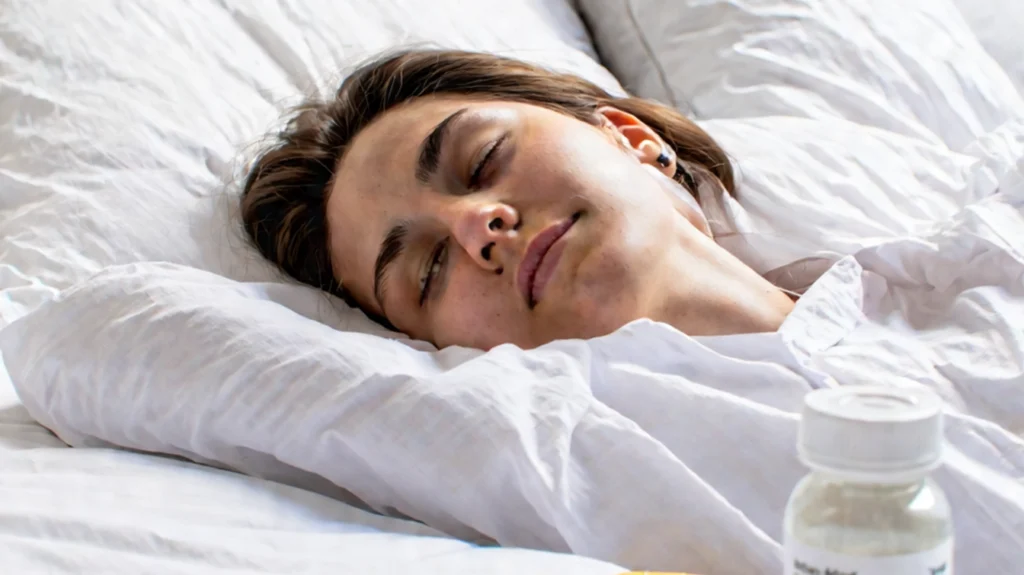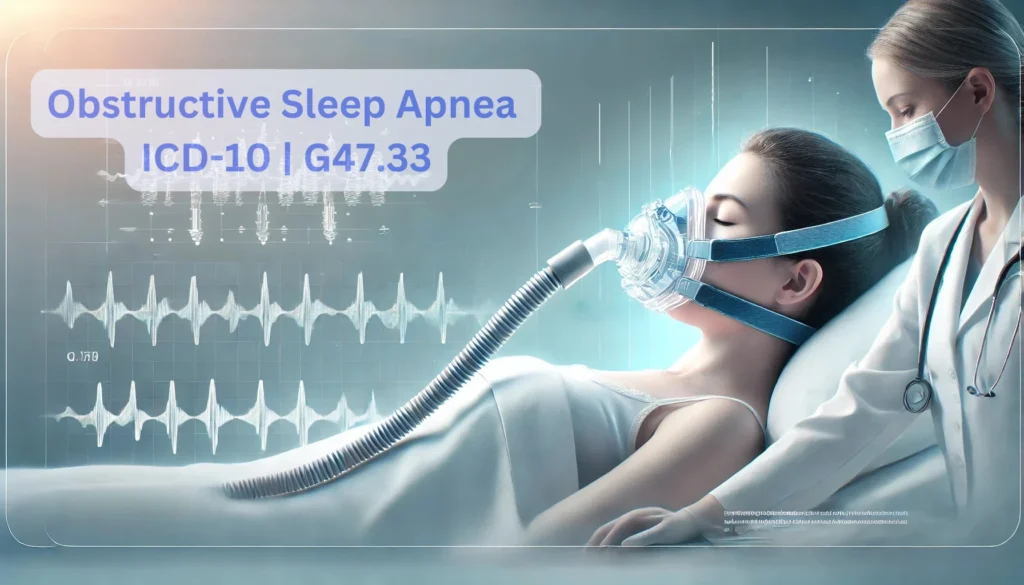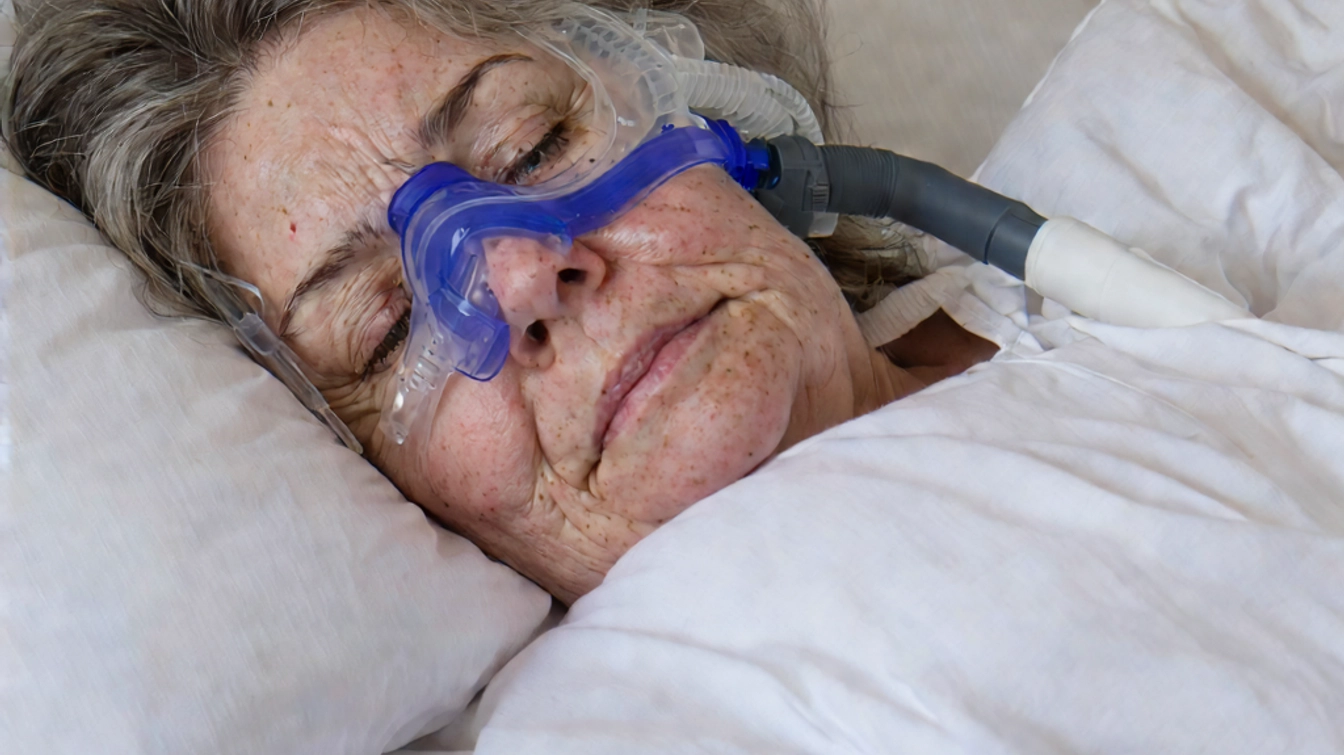Obstructive sleep apnea (OSA) is more than just snoring; it’s a serious condition with symptoms like interrupted breathing, daytime fatigue, and health risks. ICD-10 Code classifies OSA as a sleep disorder linked to heart disease and stroke. Explore FDA-approved obstructive sleep apnea (OSA) treatments options , including lifestyle changes and advanced therapies, to improve sleep and overall well-being.
Whether you’re seeking FDA-approved treatments, exploring lifestyle changes, or navigating the complexities of ICD-10 Code coding for OSA, this guide will provide you with actionable insights. Treatments like Nuvigil (Armodafinil) or lifestyle adjustments could make a meaningful difference in managing your condition. OSA occurrences are more common than many realize, and the sooner it’s addressed, the better your quality of life will be. Learn how to restore your rest and protect your health today.
What Is Obstructive Sleep Apnea?
Obstructive sleep apnea (OSA) is a condition that causes your breathing to repeatedly stop and start while you sleep. It happens when the muscles supporting your airway relax too much, leading to blockages in airflow. While occasional snoring may be benign, OSA takes it to another level, creating serious risks for your health and quality of life if it’s left untreated.
How Obstructive Sleep Apnea Occurs
So, what actually happens during sleep when OSA strikes? Think of your airway as a narrow hallway where airflow should move freely. In OSA, the muscles at the back of the throat, including the tongue and soft palate, can relax excessively during sleep. This relaxation causes the airway to become partially or completely blocked. When the airway completely closes, it leads to apnea (a pause in breathing). A partial blockage, on the other hand, results in hypopnea, or shallow breathing.
These episodes disrupt the oxygen supply to the body, triggering brief awakenings that you might not even notice. These “micro-arousals” ruin sleep quality and leave you feeling drained the next day. Over time, this oxygen deprivation and sleep disturbance can contribute to conditions like heart disease, high blood pressure, and even memory issues.
Statistics and Prevalence of OSA
You’re not alone if you deal with OSA – it’s more common than many people think. Globally, researchers estimate that nearly 1 billion people are affected by OSA, with millions in the U.S. alone likely going undiagnosed. Among adults, it’s more prevalent in men than women, but post-menopausal women also face an increased risk.
Here’s what makes it alarming: prevalence rates are climbing, largely driven by obesity, a significant risk factor. According to studies, approximately 25% of middle-aged men and 10-15% of middle-aged women meet diagnostic criteria for OSA. What’s more, many people might not realize they have it, mistaking symptoms like fatigue or snoring for less serious concerns.
Want to dive deeper into recognizing OSA and its associated risks? Treatments like Artvigil 150 mg or related FDA-approved OSA treatments options can help alleviate symptoms, making it easier to manage your condition effectively. Don’t underestimate the impact of chronic sleep disorders on your overall health – awareness is the first step to improvement.
Recognizing Obstructive Sleep Apnea Symptoms
Understanding the symptoms of obstructive sleep apnea (OSA) is the first step toward early diagnosis and effective treatment. This condition goes beyond mere snoring—it’s a disruptive force that interrupts restful sleep and threatens your overall health. Whether you’re experiencing excessive daytime fatigue or someone has witnessed your breathing pauses during sleep, being informed could make all the difference in your quality of life.
Associated Risk Factors
Did you know that certain physical attributes and lifestyle choices can significantly increase your risk of OSA? Here are the most common factors:
- Obesity: Carrying extra weight, particularly around your neck, can compress the airway, causing obstruction during sleep. Obesity remains one of the strongest predictors for OSA.
- Age: Although OSA can occur at any age, it becomes more common in men over the age of 40 and post-menopausal women.
- Craniofacial Abnormalities: Features like a recessed jaw, enlarged tonsils, or a crowded oropharynx can block airflow during sleep.
- Lifestyle Choices: Smoking, alcohol consumption, and even inadequate sleep hygiene can exacerbate OSA. Smoking irritates the airways, alcohol relaxes the throat muscles excessively, and poor sleep routines disrupt the body’s circadian rhythm.
If one or more of these factors resonate with your experience, consider discussing them with your healthcare provider. Early awareness can lead to impactful changes.
Complications of Untreated OSA
Ignoring Obstructive Sleep Apnea symptoms can have serious ripple effects on your physical and mental well-being. Here’s what might happen if the condition goes untreated:
- Cardiovascular Diseases: OSA poses a risk for hypertension, atrial fibrillation, and even stroke. The strain that apnea episodes place on the heart shouldn’t be underestimated.
- Reduced Quality of Life: Daytime sleepiness affects your productivity and overall sense of well-being. It’s not just about the fatigue—it impacts memory, mood, and even personal relationships.
- Increased Accident Risks: Sleep deprivation caused by OSA can slow reaction times, making driving or operating machinery particularly dangerous. In fact, OSA has been linked to a higher likelihood of road accidents.
Recognizing these symptoms and complications is essential, not only for your health but for your overall peace of mind. By understanding OSA’s risk factors and potential outcomes, you’re taking proactive steps toward managing its impact on your life. Don’t let this condition control you—reach out and explore proven treatments options for OSA.
Diagnosing Obstructive Sleep Apnea
A significant step toward managing obstructive sleep apnea (OSA) begins with a proper diagnosis. Understanding how OSA is detected can prepare you or a loved one for the process, making it less intimidating. Here’s what you need to know about the main diagnostic tools for this sleep disorder.
Polysomnography: The Gold Standard
Polysomnography (often abbreviated as PSG) remains the gold standard for diagnosing obstructive sleep apnea. Why? Because it provides a detailed, comprehensive look at what’s happening with your body while you sleep. Think of it as a full-body health check, but for your night-time respiratory system.
During a polysomnography test, you spend a night in a sleep lab. Various sensors are attached to monitor important aspects such as:
- Breathing Patterns: Detecting apneas (complete pauses in breathing) or hypopneas (shallow breaths that disrupt oxygen levels).
- Oxygen Levels: Measuring how well your blood remains oxygenated during sleep.
- Brain Activity: Tracking sleep stages and identifying any disruptions caused by apneas.
- Body Movements: Detecting subtle shifts or larger movements during apnea events.
The procedure might sound overwhelming, but it’s non-invasive and safe. Trained specialists analyze the data to determine whether OSA is present, and if so, gauge its severity. This level of precision makes PSG invaluable for tailoring treatment plans.
Home Sleep Apnea Testing
Home Sleep Apnea Testing (HSAT) offers a more convenient alternative to in-lab studies but isn’t without its limitations. If you’re someone who finds lab settings uncomfortable or inaccessible, HSAT can be a practical first step.
Here’s how HSAT stacks up:
- Functionality: You typically wear a device that monitors airflow, breathing patterns, and blood oxygen levels while sleeping in the comfort of your home.
- Advantages: It’s less expensive, more accessible, and uses fewer sensors. A major plus if you’re looking to sidestep the complexity of a sleep lab.
- Limitations: Unlike polysomnography, HSAT may miss other sleep issues or underestimate the severity of mild apnea cases. It also doesn’t monitor sleep stages or detailed movements, narrowing its scope.
So, who benefits most from HSAT? It’s ideal if your doctor suspects moderate to severe obstructive sleep apnea based on your symptoms and medical history. However, if results are inconclusive, follow-up testing in a lab is often recommended for deeper insight.
By understanding these diagnostic methods, you’re already one step closer to better sleep and improved health. Stay informed, ask questions, and put your well-being first.
Comprehensive Treatment Options for Obstructive Sleep Apnea(OSA)
If you’re dealing with obstructive sleep apnea (OSA), finding the right treatment option can feel overwhelming. But with modern advancements, you have several effective options to manage or potentially resolve the condition. These treatments range from proven approaches like CPAP therapy to newer, cutting-edge devices that offer alternatives for people who need something different. Explore what’s available and discover the right fit for your needs.

Continuous Positive Airway Pressure (CPAP) Therapy
CPAP therapy is widely regarded as the gold standard for treating obstructive sleep apnea. It uses a machine to deliver continuous air pressure through a mask, keeping your airway open throughout the night.
Why Choose CPAP?
- It significantly reduces breathing interruptions.
- Improves overall sleep quality and daytime alertness.
- Reduces associated risks such as high blood pressure and heart disease.
Challenges with Adherence Though incredibly effective, CPAP has its hurdles. Many people struggle with adjusting to the mask or machine noise. However, modern CPAP devices are now quieter and more comfortable than ever, making it easier to stay consistent.
Oral Appliances
If CPAP isn’t a fit, oral appliances like mandibular advancement devices (MADs) can offer a practical alternative. These dental devices work by repositioning your jaw slightly forward, helping to keep your airway open.
Who Benefits the Most?
- People with mild to moderate cases of OSA.
- Those who can’t tolerate CPAP therapy.
These devices are custom-fitted by specialists and can be particularly appealing due to their portability and ease of use. However, they may not be suitable for everyone, especially in severe cases where a stronger intervention is required.
Surgical Interventions
For severe OSA or cases where other treatments fail, surgery may be an option. Surgical solutions are generally aimed at opening up the airway or reducing obstructions.
Common Procedures Include:
- Uvulopalatopharyngoplasty (UPPP): Removes excess tissue from the throat to widen the airway.
- Maxillomandibular Advancement (MMA): Repositions the jaw to improve airflow.
- Hypoglossal Nerve Stimulation: Sends mild electrical pulses to prevent airway collapse during sleep.
Surgical treatments are generally reserved as a last resort due to their invasive nature and recovery time. Always consult with your healthcare provider to carefully weigh the risks and benefits.
Weight Management and Lifestyle Changes
For many patients, lifestyle modifications play a huge role in treating OSA. Carrying excess weight can compress the airway, so maintaining a healthy weight reduces both the frequency and severity of apnea episodes.
Key Recommendations Include:
- Weight Loss: Losing even a small percentage of body fat can have a significant impact.
- Sleep Hygiene: Maintain a consistent sleep schedule and avoid alcohol or sedatives near bedtime.
- Sleeping Position: Sleeping on your side rather than on your back can improve airflow.
Simple changes can complement other therapies and lead to better overall health.
Emerging Therapies and Devices
Innovation in OSA treatment options (FDA-approved) continues to evolve, offering new hope for those struggling with traditional therapies. Several FDA-approved OSA treatments devices and approaches show promise in improving outcomes for patients.
Notable Innovations:
- High-tech PAP Alternatives: Personalized airflow settings adapt to your breathing patterns for greater comfort.
- Expiratory Positive Airway Pressure (EPAP): A compact option designed for portability and convenience.
- Nasal Valves: Designed to facilitate breathing by increasing airway pressure.
These emerging options provide exciting alternatives to more conventional treatments, especially for those who don’t find relief with CPAP or oral appliances. As the field advances, more patients can experience the benefits of tailored solutions.
Medications for Obstructive Sleep Apnea
When it comes to managing obstructive sleep apnea (OSA), most people think of machines like CPAP or lifestyle changes, but medications can also play a role. While they aren’t typically the first line of treatment, certain drugs are being used or developed to manage symptoms, especially in patients who struggle with conventional therapies. Here’s what you should know.
FDA-Approved Medications for OSA Treatments
The FDA has approved specific medications to target symptoms associated with obstructive sleep apnea (OSA) treatments, particularly excessive daytime sleepiness. These drugs work to improve alertness and focus during waking hours, addressing one of the major quality-of-life issues associated with OSA.
- Modafinil and Armodafinil: FDA-approved these medications are often prescribed to improve wakefulness in adults who experience residual sleepiness despite other OSA treatments options like CPAP. They help by stimulating the brain, making you feel more awake and reducing fatigue.
- Solriamfetol (Sunosi): A newer medication, this works by targeting chemicals in the brain to reduce tiredness. It’s particularly effective if you’re experiencing ongoing daytime fatigue.
Medications like these focus on symptom relief rather than resolving the underlying airway obstruction, so they are generally part of a broader treatment plan.
Addressing OSA-Related Symptoms Through Medication
Though medications aren’t a cure, they help manage certain aspects of OSA. You might benefit from targeted drug therapies depending on your specific challenges. Here are some areas where medications could make a difference:
- Improving Alertness: Drugs like stimulants prevent the debilitating daytime drowsiness that often comes with OSA.
- Weight Loss Support: For those with obesity-induced OSA, certain weight loss drugs may aid in reducing body weight, indirectly helping the condition.
- Reducing Inflammation: Anti-inflammatory medications can reduce swelling in the upper airway, although this is still an area under investigation.
Medications in Development
There’s exciting progress in the realm of sleep medicine research, with new medications under trial aimed at treating OSA more directly. These medications focus on improving airway muscle tone or addressing central nervous system elements tied to sleep regulation.
If you’re curious about how medication may fit into your treatment plan, make sure to explore all your options with your healthcare provider. This combined approach ensures you’re tackling both the symptoms and root causes of obstructive sleep apnea.
Understanding ICD-10 Code for Obstructive Sleep Apnea(OSA)
In the world of medical documentation, accurate coding is essential. Whether you’re a medical professional or someone navigating healthcare systems, understanding how ICD-10 codes apply to obstructive sleep apnea (OSA) ensures proper documentation and billing. These codes don’t just simplify healthcare operations—they create a universal language for diagnosing and treating patients effectively. Let’s dive into the details.

Common ICD-10 Codes for OSA
When it comes to OSA, ICD-10 Code helps classify the condition with precision. For example, G47.33 is the standard code for diagnosing obstructive sleep apnea in adults or pediatrics. This specific code allows healthcare providers to document instances of OSA for insurance claims, patient history, and treatment planning.
Here’s where G47.33 makes a practical impact:
- In Adult Cases: Whether it’s mild, moderate, or severe, G47.33 is reflective of all forms of OSA.
- Pediatric Scenarios: For children struggling with OSA, the same code applies, ensuring parity across age groups.
Other related codes might come into play when differentiating symptoms or complications. Using the correct code not only affects how care is coordinated but also ensures that treatment aligns with diagnostic accuracy. Every accurate entry is a step closer to improving patient care.
Importance of Accurate Coding
Why does precision in ICD-10 Code for OSA matter so much? Because accurate documentation lays the foundation for effective treatment, billing, and patient outcomes. If a healthcare provider fails to use the right code, insurance claims may be denied, and patients could face delays in receiving life-changing treatments.
Consider this: Imagine your healthcare provider misclassifies your condition. This misclassification not only complicates insurance reimbursements but may also result in you receiving the wrong treatment plan. For a condition like OSA, that could impact your sleep quality and long-term health.
Here’s how accurate coding benefits everyone involved:
- Streamlined Billing: Insurance companies rely on correct codes to process claims efficiently.
- Enhanced Treatment Plans: It ensures that your diagnosis aligns precisely with recommended treatments, whether it’s CPAP therapy, surgery, or another option.
- Epidemiological Insight: Accurate coding contributes to tracking OSA’s prevalence, helping public health initiatives and research efforts.
The mechanism of ICD-10 Code for OSA isn’t just about numbers; it’s about translating complex health conditions into actionable insights for all stakeholders. Whether you’re managing your own OSA or supporting someone else, knowing the role of accurate ICD-10 Code for OSA could be key to better outcomes.
Conclusion
Obstructive sleep apnea can disrupt your sleep, health, and daily life, but proactive diagnosis and treatment make a meaningful difference. By recognizing symptoms early, exploring options like CPAP, oral appliances, medications, or lifestyle changes, you can regain control of your well-being.
More severe cases may benefit from advanced solutions, including personalized medical devices or tailored consultations. Take the necessary steps by consulting with a specialist to find the most effective strategy for you.

